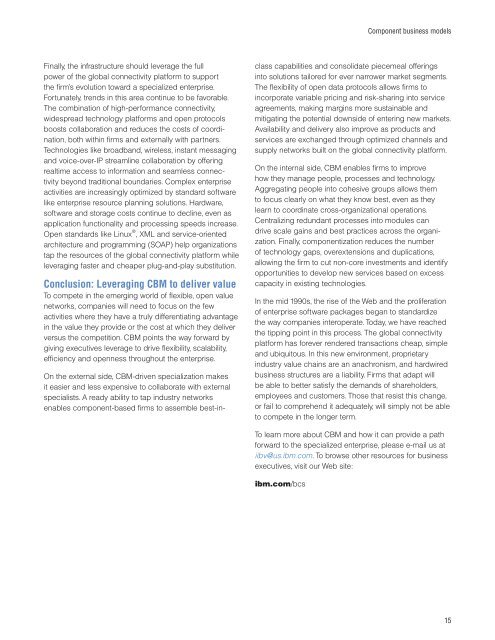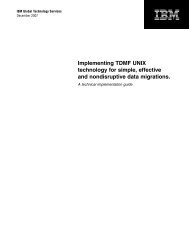Component business models - IBM
Component business models - IBM
Component business models - IBM
Create successful ePaper yourself
Turn your PDF publications into a flip-book with our unique Google optimized e-Paper software.
Finally, the infrastructure should leverage the full<br />
power of the global connectivity platform to support<br />
the firm’s evolution toward a specialized enterprise.<br />
Fortunately, trends in this area continue to be favorable.<br />
The combination of high-performance connectivity,<br />
widespread technology platforms and open protocols<br />
boosts collaboration and reduces the costs of coordination,<br />
both within firms and externally with partners.<br />
Technologies like broadband, wireless, instant messaging<br />
and voice-over-IP streamline collaboration by offering<br />
realtime access to information and seamless connectivity<br />
beyond traditional boundaries. Complex enterprise<br />
activities are increasingly optimized by standard software<br />
like enterprise resource planning solutions. Hardware,<br />
software and storage costs continue to decline, even as<br />
application functionality and processing speeds increase.<br />
Open standards like Linux ® , XML and service-oriented<br />
architecture and programming (SOAP) help organizations<br />
tap the resources of the global connectivity platform while<br />
leveraging faster and cheaper plug-and-play substitution.<br />
Conclusion: Leveraging CBM to deliver value<br />
To compete in the emerging world of flexible, open value<br />
networks, companies will need to focus on the few<br />
activities where they have a truly differentiating advantage<br />
in the value they provide or the cost at which they deliver<br />
versus the competition. CBM points the way forward by<br />
giving executives leverage to drive flexibility, scalability,<br />
efficiency and openness throughout the enterprise.<br />
On the external side, CBM-driven specialization makes<br />
it easier and less expensive to collaborate with external<br />
specialists. A ready ability to tap industry networks<br />
enables component-based firms to assemble best-in-<br />
<strong>Component</strong> <strong>business</strong> <strong>models</strong><br />
class capabilities and consolidate piecemeal offerings<br />
into solutions tailored for ever narrower market segments.<br />
The flexibility of open data protocols allows firms to<br />
incorporate variable pricing and risk-sharing into service<br />
agreements, making margins more sustainable and<br />
mitigating the potential downside of entering new markets.<br />
Availability and delivery also improve as products and<br />
services are exchanged through optimized channels and<br />
supply networks built on the global connectivity platform.<br />
On the internal side, CBM enables firms to improve<br />
how they manage people, processes and technology.<br />
Aggregating people into cohesive groups allows them<br />
to focus clearly on what they know best, even as they<br />
learn to coordinate cross-organizational operations.<br />
Centralizing redundant processes into modules can<br />
drive scale gains and best practices across the organization.<br />
Finally, componentization reduces the number<br />
of technology gaps, overextensions and duplications,<br />
allowing the firm to cut non-core investments and identify<br />
opportunities to develop new services based on excess<br />
capacity in existing technologies.<br />
In the mid 1990s, the rise of the Web and the proliferation<br />
of enterprise software packages began to standardize<br />
the way companies interoperate. Today, we have reached<br />
the tipping point in this process. The global connectivity<br />
platform has forever rendered transactions cheap, simple<br />
and ubiquitous. In this new environment, proprietary<br />
industry value chains are an anachronism, and hardwired<br />
<strong>business</strong> structures are a liability. Firms that adapt will<br />
be able to better satisfy the demands of shareholders,<br />
employees and customers. Those that resist this change,<br />
or fail to comprehend it adequately, will simply not be able<br />
to compete in the longer term.<br />
To learn more about CBM and how it can provide a path<br />
forward to the specialized enterprise, please e-mail us at<br />
iibv@us.ibm.com. To browse other resources for <strong>business</strong><br />
executives, visit our Web site:<br />
ibm.com/bcs<br />
15

















